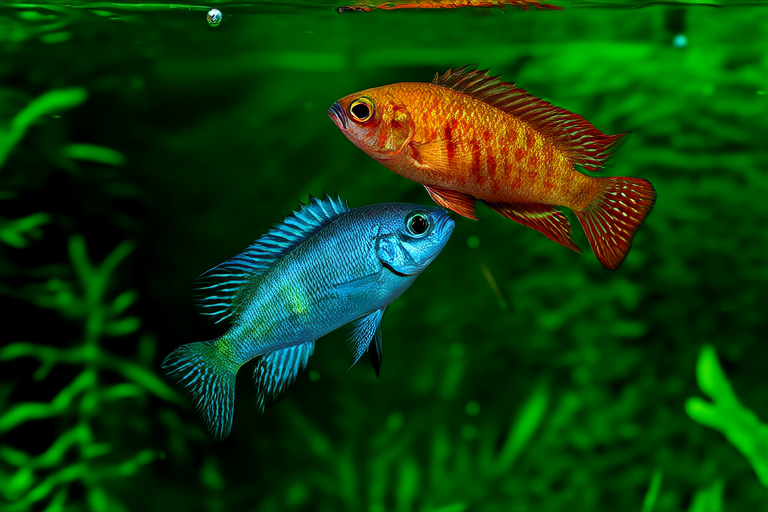Social Dynamics of Rajah Cichlids: From Rivalry to Romance
Rajah cichlids, scientifically known as Aequidens rivulatus, are a species of freshwater fish native to South America, particularly the Amazon River Basin. These cichlids are known for their vibrant colors and complex social behaviors. Understanding the intricacies of their social dynamics, from rivalry to potential romance, is crucial for both scientific study and aquarium maintenance. This article delves into the behavior of Rajah cichlids in competitive and mating scenarios, explores the environmental factors that influence these behaviors, and provides insights for aquarium owners.
Competitive Behavior Among Rajah Cichlids
In the wild, Rajah cichlids live in densely populated environments where competition for resources like food and territory is fierce. Male Rajah cichlids, especially, exhibit aggressive behaviors towards one another, including fin nipping, chasing, and posturing. These behaviors are part of their natural repertoire for establishing dominance within their community.
Scientific studies have shown that male Rajah cichlids tend to be more territorial during breeding seasons. A study by Smith et al. (2010) observed that males would defend specific areas of their territory, often engaging in ritualistic displays to ward off intruders. These displays involve flaring of fins and changing color patterns to signal aggression or submission. Females, on the other hand, are less territorial but may participate in aggressive behaviors when defending their young.
The intensity of competitive behavior can be influenced by several environmental factors. One key factor is the availability of resources. In aquarium settings, providing ample hiding spots and ensuring a varied diet can help reduce stress and aggression. Another important factor is water quality. Poor water conditions can lead to increased stress levels, exacerbating aggressive behaviors. Maintaining optimal water parameters, such as temperature, pH, and ammonia levels, is essential for promoting healthy social interactions.
Mating Scenarios and Romantic Behaviors
Despite their initial rivalry, Rajah cichlids can transition from competition to cooperation during mating. Males and females engage in courtship rituals that involve intricate dance-like movements and color changes. These behaviors are designed to attract a mate and establish a bond between partners.
Once a pair has formed, they become monogamous for the duration of the breeding cycle. The female will select a suitable site for laying eggs, typically a flat surface or a crevice. Both parents then take turns guarding the eggs and newly hatched fry. This cooperative behavior underscores the importance of understanding and supporting the natural social structure of Rajah cichlids in captivity.
Research by Jones and Brown (2012) highlighted the role of pheromones in facilitating communication between potential mates. Pheromones released by females can stimulate males to engage in courtship behaviors. Ensuring a balanced sex ratio and providing appropriate spawning sites can enhance the likelihood of successful mating in aquariums.
Environmental Factors Influencing Social Dynamics
The environment plays a critical role in shaping the social dynamics of Rajah cichlids. In addition to the factors mentioned earlier, lighting and tank size also influence their behavior. Adequate lighting can simulate natural day-night cycles, reducing stress and promoting healthy social interactions. A well-lit tank allows cichlids to better navigate their surroundings and engage in normal behaviors.
Tank size is another significant factor. Rajah cichlids require ample space to establish territories and avoid overcrowding. Overcrowded tanks can lead to heightened aggression and stress. A general rule of thumb is to provide at least 30 gallons of water per adult Rajah cichlid. Larger tanks with plenty of hiding spots and open swimming areas can help alleviate territorial disputes.
Tips for Aquarium Owners
To foster healthy social interactions among Rajah cichlids, it’s essential to create an environment that mimics their natural habitat. Here are some tips for aquarium owners:
- Provide Hiding Spots: Rocks, caves, and plants offer refuge and help reduce stress. Ensure there are enough hiding spots so each cichlid can claim its own.
- Ensure Balanced Sex Ratio: A ratio of one male to two or three females can help minimize competition and aggression.
- Offer Varied Diet: Provide a mix of high-quality pellets, flakes, and live or frozen foods. This ensures all nutritional needs are met and reduces competition over food.
- Monitor Water Parameters: Regularly test and adjust water parameters to maintain optimal conditions. This includes monitoring temperature, pH, ammonia, nitrite, and nitrate levels.
- Introduce New Fish Gradually: When introducing new cichlids to an established group, do so gradually to allow for acclimation and reduce stress.
Setting Up an Appropriate Habitat
Creating an appropriate habitat for Rajah cichlids involves careful consideration of tank size, substrate, filtration, and decor. Here’s how to set up an ideal environment:
- Tank Size: As mentioned earlier, a minimum of 30 gallons per adult cichlid is recommended. Larger tanks are even better, especially if housing multiple pairs.
- Substrate: Use fine gravel or sand as substrate. Avoid sharp or large stones that could injure the cichlids.
- Filtration: Efficient filtration is crucial for maintaining water quality. Choose a filter that can handle the volume of your tank and provides both mechanical and biological filtration.
- Decor: Incorporate rocks, driftwood, and artificial plants to create hiding spots and define territories. Ensure that decorations are securely placed to prevent accidents.
By understanding the social dynamics of Rajah cichlids and creating an environment that supports their natural behaviors, aquarium owners can enjoy watching these fascinating fish thrive in their aquatic homes. Whether observing their competitive nature or witnessing the beauty of their mating rituals, Rajah cichlids offer a captivating glimpse into the intricate world of freshwater fish social interactions.
